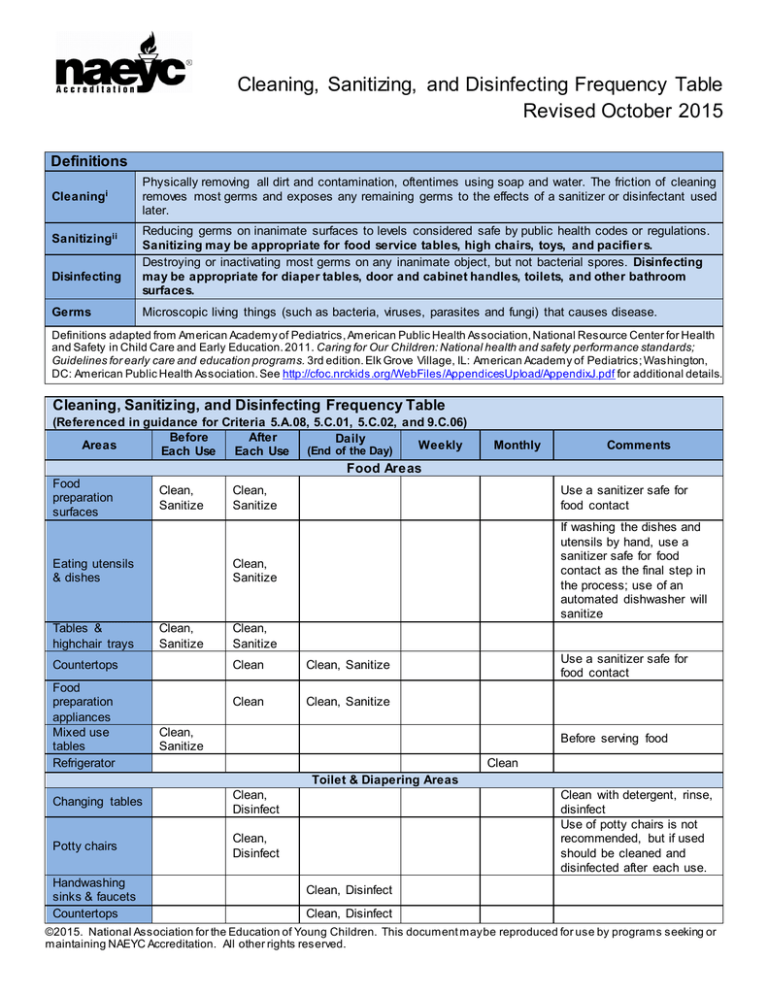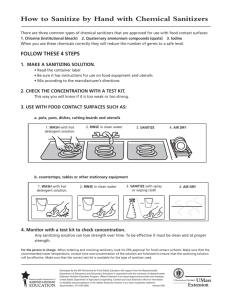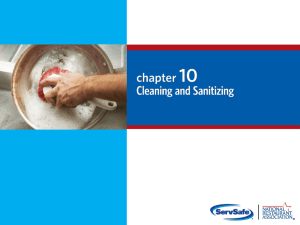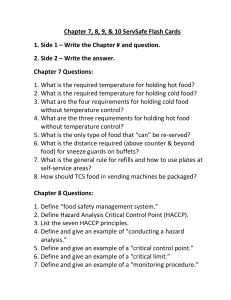
Cleaning, Sanitizing, and Disinfecting Frequency Table
Revised October 2015
Definitions
Cleaningi
Sanitizingii
Disinfecting
Germs
Physically removing all dirt and contamination, oftentimes using soap and water. The friction of cleaning
removes most germs and exposes any remaining germs to the effects of a sanitizer or disinfectant used
later.
Reducing germs on inanimate surfaces to levels considered safe by public health codes or regulations.
Sanitizing may be appropriate for food service tables, high chairs, toys, and pacifier s.
Destroying or inactivating most germs on any inanimate object, but not bacterial spores. Disinfecting
may be appropriate for diaper tables, door and cabinet handles, toilets, and other bathroom
surfaces.
Microscopic living things (such as bacteria, viruses, parasites and fungi) that causes disease.
Definitions adapted from American Academy of Pediatrics, American Public Health Association, National Resource Center for Health
and Safety in Child Care and Early Education. 2011. Caring for Our Children: National health and safety performance standards;
Guidelines for early care and education programs. 3rd edition. Elk Grove Village, IL: American Academy of Pediatrics; Washington,
DC: American Public Health Association. See http://cfoc.nrckids.org/WebFiles/AppendicesUpload/AppendixJ.pdf for additional details.
Cleaning, Sanitizing, and Disinfecting Frequency Table
(Referenced in guidance for Criteria 5.A.08, 5.C.01, 5.C.02, and 9.C.06)
Before
After
Daily
Areas
Weekly
Each Use
Each Use (End of the Day)
Monthly
Comments
Food Areas
Food
preparation
surfaces
Clean,
Sanitize
Eating utensils
& dishes
Tables &
highchair trays
Clean,
Sanitize
Countertops
Food
preparation
appliances
Mixed use
tables
Refrigerator
Clean,
Sanitize
Use a sanitizer safe for
food contact
Clean,
Sanitize
If washing the dishes and
utensils by hand, use a
sanitizer safe for food
contact as the final step in
the process; use of an
automated dishwasher will
sanitize
Clean,
Sanitize
Clean
Clean, Sanitize
Clean
Clean, Sanitize
Use a sanitizer safe for
food contact
Clean,
Sanitize
Before serving food
Clean
Toilet & Diapering Areas
Changing tables
Clean,
Disinfect
Potty chairs
Clean,
Disinfect
Handwashing
sinks & faucets
Countertops
Clean with detergent, rinse,
disinfect
Use of potty chairs is not
recommended, but if used
should be cleaned and
disinfected after each use.
Clean, Disinfect
Clean, Disinfect
©2015. National Association for the Education of Young Children. This document may be reproduced for use by programs seeking or
maintaining NAEYC Accreditation. All other rights reserved.
Cleaning, Sanitizing, and Disinfecting Frequency Table
Revised October 2015
Cleaning, Sanitizing, and Disinfecting Frequency Table
(Referenced in guidance for Criteria 5.A.08, 5.C.01, 5.C.02, and 9.C.06)
Before
After
Daily
Areas
Weekly
Each Use
Each Use (End of the Day)
Toilets
Clean, Disinfect
Diaper pails
Clean, Disinfect
Floors
Clean, Disinfect
Monthly
Comments
Damp mop with a floor
cleaner/disinfectant
Child Care Areas
Plastic mouthed
toys
Clean
Clean, Sanitize
Pacifiers
Clean
Clean, Sanitize
Hats
Clean
Door & cabinet
handles
Clean, Disinfect
Floors
Clean
Carpets iii and
Large Area
Rugs¹
Clean
Small Rugs
Reserve for use by only
one child; use dishwasher
or boil for one minute
Clean after each use if
head lice present
Clean
Clean
Clean
Sweep or vacuum, then
damp mop, (consider micro
fiber damp mop to pick up
most particles)
Daily: Vacuumiv when
children are not present;
clean with a carpet cleaning
method consistent with
local health regulations and
only when children will not
be present (until the carpet
is dry)
Monthly: Clean carpets at
least monthly in infant
areas and at least every
three months in other areas
when soiled
Daily: Shake outdoors or
vacuum
Week ly: Launder
Machine
washable cloth
toys
Dress-up
clothes
Play activity
centers
Drinking
Fountains
Computer
keyboards v
Phone receivers
Clean
Launder
Clean
Launder
Clean
Clean, Disinfect
Clean,
Sanitize
Use sanitizing wipes, do not
use spray
Clean
Sleeping Areas
©2015. National Association for the Education of Young Children. This document may be reproduced for use by programs seeking or
maintaining NAEYC Accreditation. All other rights reserved.
Cleaning, Sanitizing, and Disinfecting Frequency Table
Revised October 2015
Cleaning, Sanitizing, and Disinfecting Frequency Table
(Referenced in guidance for Criteria 5.A.08, 5.C.01, 5.C.02, and 9.C.06)
Before
After
Daily
Areas
Weekly
Each Use
Each Use (End of the Day)
Bed sheets &
Clean
pillow cases
Cribs, cots, &
Clean
mats
Blankets
Monthly
Comments
Clean before use by
another child
Clean before use by
another child
Clean
i Routine cleaning with detergent and water is the most useful method for removing germs from surfaces in the
child care setting. Safer cleaning products are not only less-toxic and environmentally safer, but they also often
cost the same as conventional cle aners. Green Seal and UL/EcoLogo are non-profit companies that research and
certify products that are biodegradable and environmentally friendly.
ii
Sanitizing and disinfecting can be achieved with a solution of bleach and water. However, the use of bleach for
disinfecting and sanitizing is not a requirement; there are other EPA-approved sanitizing and disinfecting agents.
When purchasing products, look for an EPA registration number on the product label, which will describe the
product as a cleaner, sanitizer, or disinfectant.
When sanitizing or disinfecting is warranted, it is recommended that staff use the least-toxic disinfecting and
sanitizing products available. Least-toxic disinfecting and sanitizing products have been tested and certified
by a third party group. For alternative methods and products to be used in lieu of bleach, please refer to the
Green Cleaning Toolkit for Early Care and Education, a set of resources developed by the EPA.
Follow manufacturer instructions for how to mix bleach / water solutions for sanitizing and disinfecting. Refer to Caring
for Our Children, Appendix J, (http://cfoc.nrckids.org/WebFiles/Appendice sUpload/AppendixJ.pdf ) for
instructions on how to identify EPA-registered cleaning, sanitizing and disinfecting products (including
bleach), and how to safely prepare bleach solutions.
iii
It is best practice to use alternatives to carpets in the childcare environment.
iv
All area rugs and carpeted areas should be vacuumed with a HEPA filtered vacuum and according to
instructions for the vacuum. Use proper vacuuming technique: (1) push the vacuum slowly; (2) do a double
pass—vacuum in 2 directions, perpendicular to each other; (3) start at the far end of a room and work your way
out (to avoid immediate re-contamination); (4) empty or replace vacuum bags when ½ to 2/3 full.
Each Use” of computer keyboards should be defined as use by each group of children, not each individual child.
Keyboards connected to computers should be cleaned daily if one group is in the room all day, or after each different
group of children uses the room. These guidelines do not apply to keyboards that are unplugged and used for dramatic
play.
v
©2015. National Association for the Education of Young Children. This document may be reproduced for use by programs seeking or
maintaining NAEYC Accreditation. All other rights reserved.



